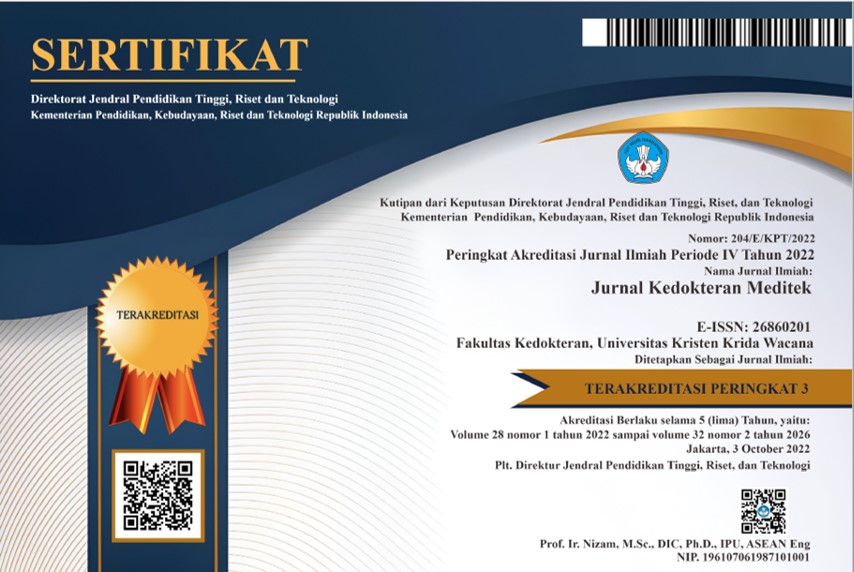Hubungan antara Adiksi Telepon Pintar dengan Refleks Berkedip dan Kuantitas Air Mata
DOI:
https://doi.org/10.36452/jkdoktmeditek.v28i1.2278Keywords:
Adiksi telepon pintar, kuantitas air mata, mahasiswa kedokteran, refleks berkedipAbstract
Adiksi telpon pintar meningkatkan paparan blue light yang bersifat merusak kornea dan lapisan air mata sehingga dapat mempengaruhi refleks berkedip dan sekresi air mata. Penelitian ini bertujuan untuk mengetahui hubungan antara adiksi telepon pintar dengan refleks berkedip dan kuantitas air mata pada mahasiswa Fakultas Kedokteran Universitas Pembangunan Nasional Veteran Jakarta. Penelitian menggunakan desain potong lintang. Sebanyak 88 subjek dengan kriteria menggunakan telpon pintar, tidak memakai softlens dan obat tetes mata serta tidak memiliki riwayat operasi mata, alergi mata, dan Sindroma Sjorgen, ditentukan menggunakan teknik simple random sampling. Data diambil menggunakan kuesioner smartphone addiction scale, rekaman video, dan Schirmer I Test. Hasil penelitian didapatkan subjek berusia 20 (18-23) tahun, 76,1% perempuan dan 45,5% menggunakan telpon pintar lebih dari 6 jam sehari. Sebanyak 52,3% subjek mempunyai adiksi telepon pintar dengan frekuensi refleks berkedip 11 (3-32) kali/menit dan kuantitas air mata 30,5 (4-35) mm dalam 5 menit. Hasil uji Mann-Whitney menunjukkan tidak ada hubungan antara adiksi telepon pintar dengan refleks berkedip (p = 0,537), tetapi ada hubungan antara adiksi telepon pintar dengan kuantitas air mata (p = 0,011).
References
Silverthorn DU, Johnson BR, Ober WC, Garrison CW, Silverthorn AC. Human physiology: an integrated approach. 7th ed. England: Pearson Education Inc, 2013. p. 364.
Kumasela GP, Saerang JSM, Rares L. Hubungan waktu penggunaan laptop dengan keluhan pengelihatan pada mahasiswa Fakutas Kedokteran Universitas Sam Ratulangi. Manado:Universitas Sam Ratulangi. J e-Biomedik. 2013;1(1):291-9.
Sherwood L. Human physiology from cells to systems. 9th ed. Canada: Cencage Learning. 2016.
Stahl U, Willcox M, Stapleton F. Osmolality and tear film dynamics.Clin Exp Optom. 2012;95(1):3–11.
Peterson D, Hamel R. Corneal Reflex..New York: StatPearls; 2019.
French K, Veys J. Seeing physics in the blink of an eye. J of Vision. 2017;17(10):203.
Palakuru JR, Wang J, Aquavella J V. Effect of blinking on tear dynamics. Investig Ophthalmol Vis Sci. 2007;48(7):3032–7.
Wang MTM, Tien L, Han A, Lee JM, Kim D, Markoulli M, et al. Impact of blinking on ocular surface and tear film parameters. Ocul Surf. 2018;16(4):424–9.
Kowalski K. Cell phones can be addictive. Disitasi pada tanggal 18 Mei 2020. Diunduh dari: https://www.commonlit.org/texts/watch-out-cell-phones-can-be-addictive?__cf_chl_jschl_tk__=pmd_ FcN92puPV5qcU66dCO.pgtmAu0Glsya0zRLYHYHIzD8-1632111099-0-gqNtZGzNAlCjcnBszQiR
Golebiowski B, Long J, Harrison K, Lee A, Chidi-Egboka N, Asper L. Smartphone use and effects on tear film, blinking and binocular vision. Curr Eye Res. 2020;45(4):428–34.
Aljomaa SS, Mohammad MF, Albursan IS, Bakhiet SF, Abduljabbar AS. Smartphone addiction among university students in the light of some variables. Comput Human Behav. 2016;61:155–64.
Li X, Feng X, Xiao W, Zhou H. Loneliness and mobile phone addiction among chinese college students: the mediating roles of boredom proneness and self-control. Psychol Res Behav Manage. 2021;14;687-94.
Billieux J, Van Der Linden M, Rochat L. The role of impulsivity in actual and problematic Use of the mobile phone. Appl Cogn Psychol. 2008;22:877–95.
Kwon M, Kim DJ, Cho H, Yang S. The smartphone addiction scale:development and validation of a short version for adolescents. PLoS One. 2013;8(12):1–7.
Kim DJ, Lim C-Y, Gu N, Park CY. Visual fatigue induced by viewing a tablet computer with a high-resolution display. Korean J Ophthalmol. 2017;31(5):388.
Jaiswal S, Asper L, Long J, Lee A, Harrison K, Golebiowski B. Ocular and visual discomfort associated with smartphones, tablets and computers: what we do and do not know. Clin Exp Optom. 2019;102(5):463–77.
Arjmandi N, Mortazavi G, Zarei S, Faraz M, Mortazavi SAR. Can light emitted from smartphone screens and taking selfies cause premature aging and wrinkles? J Biomed Phys Eng. 2018;8(4):447–52.
Choi JH, Li Y, Kim SH, Jin R, Kim YH, Choi W, et al. The influences of smartphone use on the status of the tear film and ocular surface. PLoS One. 2018;13(10):1–16.
Rizky, MR, Nawangwulan S. Metodologi penelitian kesehatan. Sidoarjo: Indomedia Pustaka; 2018.
Chen B, Liu F, Ding S, Ying X, Wang L, Wen Y. Gender differences in factors associated with smartphone addiction: a cross-sectional study among medical college students. BMC Psychiatry. 2017;17(1):1–9.
Alhazmi AA, Alzahrani SH, Baig M, Salawati EM, Alkatheri A. Prevalence and factors associated with smartphone addiction among medical students at King Abdulaziz University, Jeddah. Pakistan J Med Sci. 2018;34(4):984–8.
Gutiérrez JDS, de Fonseca FR, Rubio G. Cell-phone addiction: a review. Front Psychiatry. 2016;7.
Sethuraman AR, Rao S, Charlette L, Thatkar PV, Vincent V. Smartphone addiction among medical college students in the Andaman and Nicobar Islands. Int J Community Med Public Heal. 2018;5(10):4273-7.
Park JS, Choi MJ, Ma JE, Moon JH, Moon HJ. Influence of cellular phone videos and games on dry eye syndrome in university students. J Korean Acad Community Heal Nurs. 2014;25(1):12.
Rosenfield M, Jahan S, Nunez K, Chan K. Cognitive demand, digital screens and blink rate. Comput Human Behav. 2015;51:403–6.
Solinas M, Belujon P, Fernagut PO, Jaber M, Thiriet N. Dopamine and addiction: what have we learned from 40 years of research. Journal of Neural Transmission. 2019;126:481–516.
Jongkees BJ, Colzato LS. Spontaneous eye blink rate as predictor of dopamine-related cognitive function—A review. Neurosci Biobehav Rev. 2016;71:58–82.
Paprocki R, Lenskiy A. What does eye-blink rate variability dynamics tell us about cognitive performance? Front Hum Neurosci. 2017;11:1–9.
Leung TW, Li RW, Kee C. Blue-light filtering spectacle lenses: Optical and clinical performances. PLoS One. 2017;12(1):1–15.
Kumar BS. A study to evaluate the knowledge regarding computer vision syndrome among medical students. Biomed Pharmacol J. 2020;13(1):469–73.
Zhao ZC, Zhou Y, Tan G, Li J. Research progress about the effect and prevention of blue light on eyes. Int J Ophthalmol. 2018;11(12):1999–2003.
Sacchetti M, Rama P, Bruscolini A, Lambiase A. Limbal stem cell transplantation: Clinical results limits, and perspectives. Stem Cells Int. 2018;8086269.
Pflugfelder SC, de Paiva CS. The pathophysiology of dry eye disease: What we know and future directions for research. Ophthalmology. 2017;124(11):S4–13.
Tosini G, Ferguson I, Tsubota K. Effects of blue light on the circadian system and eye physiology. Mol Vis. 2016;22:61–72.
Downloads
Published
How to Cite
Issue
Section
License
Copyright (c) 2022 Salma Tania, Nurfitri Bustamam, Winda Lestari

This work is licensed under a Creative Commons Attribution-NonCommercial-ShareAlike 4.0 International License.


















